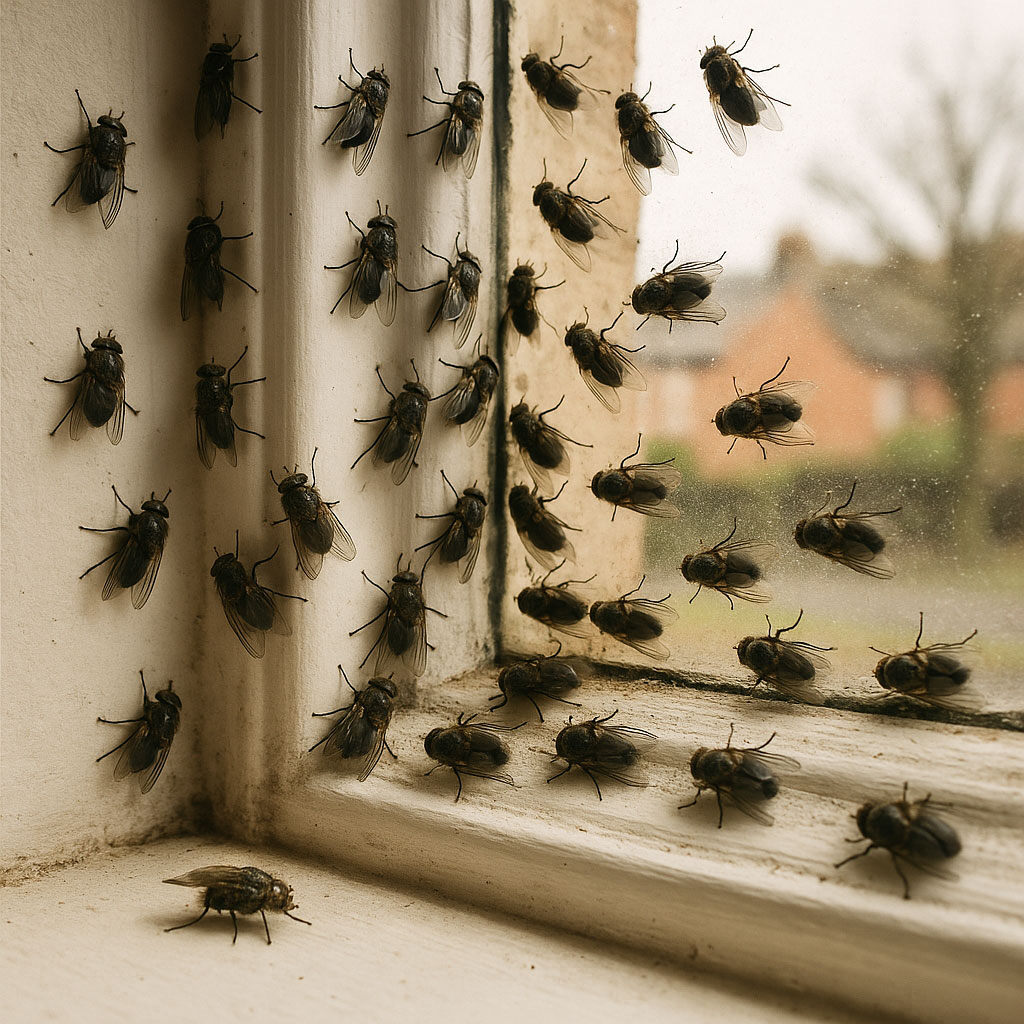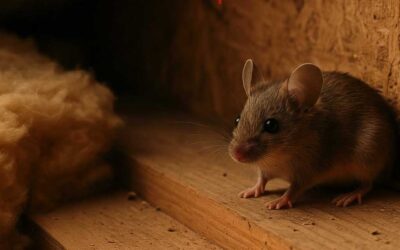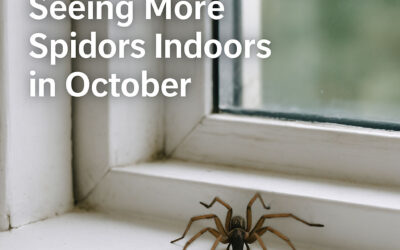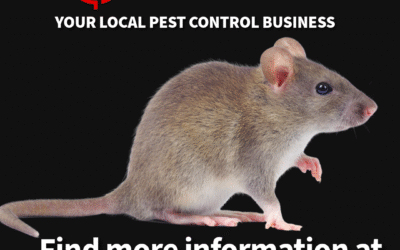Cluster Flies in Autumn – Why They Appear and What You Can Do About Them
Cluster flies are a common pest problem across rural and semi-rural areas of North Yorkshire, especially in the villages and countryside homes between York and Thirsk. As the weather begins to cool in early autumn, homeowners may notice increasing numbers of slow-moving flies gathering around windows, loft spaces, or tucked into the upper corners of rooms. This behaviour is typical of cluster flies – a seasonal nuisance that returns each year without fail.
What Are Cluster Flies?
Cluster flies (Pollenia rudis) are a distinct species from the standard housefly. They are slightly larger, often with golden hairs on their thorax and a more sluggish flight. Unlike houseflies, cluster flies are not attracted to food or waste. Instead, they live harmlessly outdoors during the summer months, feeding on nectar and other organic material. Their larvae are parasitic to earthworms, not humans or pets.
Cluster flies do not breed inside buildings and they pose no direct health risks. However, they become a significant nuisance when they start to seek out warm indoor spaces to overwinter – and that’s where the problem begins.
Why Do Cluster Flies Appear in Autumn?
From late September onwards, cluster flies begin to search for suitable places to shelter for the winter. South-facing walls, rooflines, attic voids, and older buildings with plenty of small gaps offer the perfect environment.
Once a few flies locate a warm and undisturbed loft or cavity wall, they emit a pheromone that attracts others to join them – often in large numbers. It’s not uncommon for homeowners to discover hundreds, sometimes thousands, of cluster flies gathering in lofts, around window frames, or in unused rooms.
This behaviour continues each year because cluster flies are known to return to the same building season after season. Even if you had them professionally removed in previous years, they are likely to return unless preventative measures are in place.
Common Signs of a Cluster Fly Infestation
Most people become aware of cluster flies when they notice:
-
A group of slow-moving flies around windows, especially on sunny autumn or winter days
-
Increased fly activity in lofts or attics
-
Dead or dying flies found in light fittings or window sills
-
A musty, stale smell in unused rooms, caused by large numbers of inactive flies
Because they are attracted to warmth, cluster flies may become more active again on mild winter days or if heating is turned on in a loft or spare room.
Why They’re a Nuisance
Although cluster flies are not dangerous or dirty in the traditional sense, they can cause considerable annoyance:
-
Large infestations can stain paintwork, window frames, or soft furnishings
-
Their presence in light fittings can create electrical issues
-
Dead flies accumulate and can attract other pests such as larder beetles or carpet beetles
-
If disturbed, they will often attempt to escape – creating a frustrating and unpleasant environment
For properties used seasonally (such as holiday homes or second properties in the countryside), returning after a few months away can sometimes reveal a significant problem has developed unnoticed.
Can You Prevent Cluster Flies?
While it’s very difficult to prevent cluster flies entirely – especially in older or rural properties – there are several effective steps you can take to reduce the likelihood of an infestation:
1. Seal Entry Points
Inspect your home for potential access routes. Common points of entry include:
-
Gaps under roof tiles
-
Cracks around soffits, fascia boards, and eaves
-
Loose or broken vents
-
Gaps around pipework or cable entries
Sealing these with appropriate fillers, mesh, or expanding foam can reduce access.
2. Use Fly Screens
If you have known problem windows, particularly in loft conversions or sunrooms, installing fine mesh fly screens can prevent cluster flies from settling.
3. Keep Lofts and Attics Cool
Cluster flies are drawn to warm, undisturbed spaces. If you can ventilate your loft or reduce the temperature (without causing condensation), it may make it less attractive as a winter shelter.
4. Install Insect Mesh Over Air Bricks and Vents
This stops flies from entering while still allowing airflow. Use fine-grade mesh that’s suitable for pest control purposes.
Professional Treatment for Cluster Flies
For homes and businesses where cluster flies return each year, professional treatment offers the most effective and long-term control.
At Pest Assured, we typically recommend one or a combination of the following treatments:
1. ULV Fogging (Ultra-Low Volume Insecticide Fog)
This disperses a fine mist of insecticide throughout lofts, roof spaces, or attics. It’s highly effective at reaching hidden areas where flies gather. The treatment kills existing flies and can leave a residual effect for short-term protection.
2. Residual Insecticide Sprays
These are applied to surfaces where cluster flies are known to settle. They continue to work for several weeks after application, killing flies that come into contact with treated areas.
3. Dust Treatments
In dry, undisturbed roof voids, an insecticidal dust can be used to great effect. It’s especially useful in timber-framed lofts and roof beams where flies cluster.
4. Preventative Treatments
For properties that are regularly affected, we can carry out preventative treatments just before autumn. This can reduce the number of flies that settle in your home, and significantly reduce the need for reactive work during winter.
Safe and Discreet Service
All our treatments are carried out safely, using approved products suitable for use in residential settings. If you have pets, children, or sensitive building materials, we’ll ensure the treatment plan is tailored accordingly.
We also provide discreet service vehicles and flexible appointment times across the area between Thirsk and York. Whether it’s a one-off treatment or an annual control plan, we’re here to help.
What Not to Do
-
Do not use household fly sprays in roof voids – they are unlikely to reach the flies and can pose a fire hazard
-
Avoid vacuuming large groups of flies without a suitable HEPA filter – it may spread allergens
-
Do not ignore the issue – it’s unlikely to go away on its own and may worsen each year
When to Call in the Professionals
If you’re seeing more than a few flies, or they return repeatedly despite your efforts, it’s time to speak to a qualified pest control technician.
Cluster flies can quickly go from a mild nuisance to a persistent, unpleasant issue. Early intervention in September or October is ideal, but we can treat infestations at any time of year.
Pest Assured operates throughout the villages and towns between Thirsk and the south of York. We’re based in Huby and are proud to be a local, reliable service – not a national franchise.
To book an inspection or request a treatment plan, get in touch today:
📞 07375 775 999
📧 enquiries@yorkpests.co.uk








